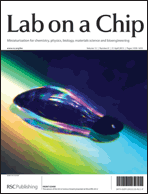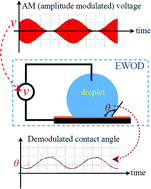 As highlighted on the outside front cover, physicists, engineers and chemists at the University of Illinois , USA, describe a new laser-based label-free resonant optical biosensor with high resolution and high sensitivity. The difference with this sensor is that they use a photonic crystal resonant reflector surface to introduce optical gain to the sensor from an external source via simulated emission. All of our cover articles are free to access for 6 weeks,* so you can read the full work now:
As highlighted on the outside front cover, physicists, engineers and chemists at the University of Illinois , USA, describe a new laser-based label-free resonant optical biosensor with high resolution and high sensitivity. The difference with this sensor is that they use a photonic crystal resonant reflector surface to introduce optical gain to the sensor from an external source via simulated emission. All of our cover articles are free to access for 6 weeks,* so you can read the full work now:
External cavity laser biosensor
Chun Ge, Meng Lu, Sherine George, Timothy A. Flood, Clark Wagner, Jie Zheng, Anusha Pokhriyal, J. Gary Eden, Paul J. Hergenrother and Brian T. Cunningham
DOI: 10.1039/C3LC41330F
 On the inside front cover, researchers at California Institute of Technology, USA, and LeukoDx Inc., Israel, present a point-of-care test for leukocyte counting using a microflow cytometer and fluorescent dye. This method eliminated excessive dilution and sheath flow, giving a minimal needed sample volume.
On the inside front cover, researchers at California Institute of Technology, USA, and LeukoDx Inc., Israel, present a point-of-care test for leukocyte counting using a microflow cytometer and fluorescent dye. This method eliminated excessive dilution and sheath flow, giving a minimal needed sample volume.
Four-part leukocyte differential count based on sheathless microflow cytometer and fluorescent dye assay
Wendian Shi, Luke Guo, Harvey Kasdan and Yu-Chong Tai
DOI: 10.1039/C3LC41059E
 Work from Tino Frank and Savaş Tay at ETH Zurich is featured on the inside back cover. To improve studies of cell signalling in vitro, this article introduces a simple cell culture platform that can produce programmable diffusion-based gradients using microfluidics based on modifying flow over time. Read it here:
Work from Tino Frank and Savaş Tay at ETH Zurich is featured on the inside back cover. To improve studies of cell signalling in vitro, this article introduces a simple cell culture platform that can produce programmable diffusion-based gradients using microfluidics based on modifying flow over time. Read it here:
Flow-switching allows independently programmable, extremely stable, high-throughput diffusion-based gradients
Tino Frank and Savaş Tay
DOI: 10.1039/C3LC41076E
 The outside back cover highlights the work of Sung Gap Im at KAIST, South Korea. This article is about a doubly cross-linked nano-adhesive system (DCNA) and the team demonstrate fabrication of microfluidic devices with flexible and rigid substrates with high strength and stability. The flexible devices could be manipulated without delamination occurring.
The outside back cover highlights the work of Sung Gap Im at KAIST, South Korea. This article is about a doubly cross-linked nano-adhesive system (DCNA) and the team demonstrate fabrication of microfluidic devices with flexible and rigid substrates with high strength and stability. The flexible devices could be manipulated without delamination occurring.
A doubly cross-linked nano-adhesive for the reliable sealing of flexible microfluidic devices
Jae Bem You, Kyoung-Ik Min, Bora Lee, Dong-Pyo Kim and Sung Gap Im
DOI: 10.1039/C2LC41266G
In addition to the primary microfluidics research and high number of HOT articles in issue 7, there are also three critical reviews:
Microfabricated mammalian organ systems and their integration into models of whole animals and humans
Jong H. Sung, Mandy B. Esch, Jean-Matthieu Prot, Christopher J. Long, Alec Smith, James J. Hickman and Michael L. Shuler
DOI: 10.1039/C3LC41017J
Thinking big by thinking small: application of microfluidic technology to improve ART
J. E. Swain, D. Lai, S. Takayama and G. D. Smith
DOI: 10.1039/C3LC41290C
Nucleic acid amplification using microfluidic systems
Chen-Min Chang, Wen-Hsin Chang, Chih-Hung Wang, Jung-Hao Wang, John D. Mai and Gwo-Bin Lee
DOI: 10.1039/C3LC41097H
*Free access to individuals is provided through an RSC Publishing personal account. Registration is quick, free and simple










